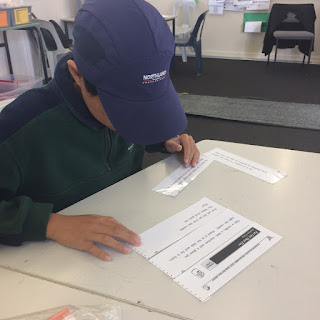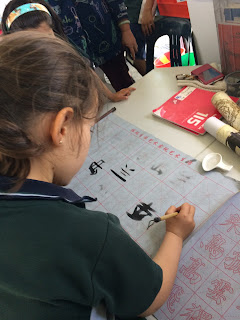At the moment in our English class we are doing Rainbow Reading.
This programme encourages fluency. We have to listen to a story on a CD, read the story out loud with a buddy and complete sequencing and cloze activities with the book.
Have a look at some of our seniors below....
Wednesday, 16 November 2016
Saturday, 29 October 2016
Chinese celebrations and customs
Last week we learnt about traditional Chinese celebrations and customs, in particular Chinese New Year.
We were lucky to have one of our students Angela's, grandparents and father in to talk to us about this.
We tried a delicious Chinese beef dish and learnt about calligraphy, it was lovely to have visitors to our class - thank you Angela :)
We were lucky to have one of our students Angela's, grandparents and father in to talk to us about this.
We tried a delicious Chinese beef dish and learnt about calligraphy, it was lovely to have visitors to our class - thank you Angela :)
Tuesday, 11 October 2016
Diwali
We have been learning about Diwali, the Indian festival of light.
During 'Diwali' people create Rangoli patterns at the entrance way to their homes and meeting places to welcome people. These patterns are bright, colourful and beautiful.
We made our own Rangoli patterns around the school, have a look at them below.
During 'Diwali' people create Rangoli patterns at the entrance way to their homes and meeting places to welcome people. These patterns are bright, colourful and beautiful.
We made our own Rangoli patterns around the school, have a look at them below.
Wednesday, 13 July 2016
English Class Open Day
We had two open days in our English classroom. It was lovely to have parents come and be part of our learning. Thank you very much to all the parents who came. We hope to see you all again soon.
Thursday, 16 June 2016
Elephant and Piggie -By Mo Williams
We have been enjoying reading the Elephant and Piggie series of books by Mo Williams.
We think the stories are very funny! We have been having turns at reading them to the class...
We decided to make our own Elephant and Piggie stories... Watch this space and we will post them up when we have finished.
We think the stories are very funny! We have been having turns at reading them to the class...
We decided to make our own Elephant and Piggie stories... Watch this space and we will post them up when we have finished.
Thursday, 2 June 2016
Writing Instructions....
In class we have been learning how to write clear, easy to follow instructions.
We have had fun making a range of things to write about.
We have made, Hot Chocolates, Popcorn, Marshmallow Sandwiches and Origami Fortune Tellers.
Have a look at some of the photos.
We have had fun making a range of things to write about.
We have made, Hot Chocolates, Popcorn, Marshmallow Sandwiches and Origami Fortune Tellers.
Have a look at some of the photos.
Thursday, 19 May 2016
Our middle school class
Here are some photos of our middle school English group doing some reading games and activities with their friends...
Sunday, 1 May 2016
Wednesday, 13 April 2016
Year 1 English Class
In our Year 1 class we have been learning about characters.
We read Goldilocks and the Three bears and talked about the different characters in the story.
Then just for fun, we acted out the story.
We tried to use the right voice for our characters. Have a look at the videos below to see us acting out part of the story.
\
Reading at home
A great article about how to help your child with their reading at home. Not written for English Language Learners - But some wonderful ideas anyway...

If your child comes across a word they don't know, use the pause, prompt, praise technique:
Pause - wait a few seconds and give your child time to think. Often they will work it out by themselves.
Prompt - if they still don't know the word, try a couple of the following:
Look at the beginning of the word and discuss the letters and sound.
Talk about words that would make sense in the sentence.
Look for clues in the pictures
Ask your child to go back to the beginning of the sentence or to read on to the end of the sentence If your child still doesn't know the word, tell them and prompt them to read the sentence again.
Praise your child for getting the word right or for trying hard.
What do I do when my child doesn't know the word?
There are a number of things that you can do when you are reading with your child and they come to a word they don't know. My first piece of advice is to avoid eye contact with the child. When a child looks to us for help with a word, we often want to save them, help the reading process move along and provide the word. However, this is an unsustainable strategy for the child as they need a set of skills to call upon when they are reading with you. Rather than looking at your child, focus your attention on the book. After all, this is where all the clues are to figuring out the word. Encourage your child to skip the word and read on for more information, use the pictures for a clue, or even leave the word behind and continue reading. By refocusing the child's attention back to the meaning of the text, the content of the text will help fill in the blanks. If your child has skipped the word and still can't figure it out, drop the word into the conversation as you turn the page.
Should I get my child to practise individual words they're having trouble with?
Learning words in isolation does not always translate to being able to figure out unknown words in texts. Consider learning the word duck: you could write this on a card for your child to learn, look at pictures of ducks when learning the word and talk about ducks that you've both seen at the park together. However, when your child reads the word duck in a passage about cricket, the meaning is considerably different. The best way to learn words therefore is in context - in books. Point out interesting words that you encounter in the text after you've finished reading and think about where you've seen these before. Reading widely and frequently is the best way to build your child's vocabulary and increase their bank of known words.
My child spends too long looking at the pictures when they are reading; should I cover the pictures so they can concentrate? No! A frequent misconception about the reading process is that when children are spending too long looking at the pictures they are getting distracted. When a child is looking at the pictures, they are gaining valuable information about the meaning of the text. The clues that are visible in the illustrations are often the best way to figure out the meaning of the text. Encouraging your child to flick through the text before reading, or doing "book orientation", where you first discuss the book, its title and the pictures, is one of the best ways to help your child's reading progression.

Thursday, 17 March 2016
Rube Goldberg machines
The senior groups have been learning about Rube Goldberg machines in class. We decided to have a go at making them in our English Class.
We used all sorts of materials and we had to make lots of moderation's to our machines. Have a look below at some writing and photos.
We used all sorts of materials and we had to make lots of moderation's to our machines. Have a look below at some writing and photos.
Rube
Goldberg Machine
On Thursday, l made a domino run with
Andrew.
We used dominoes, cardboard tubes,
wooden blocks, marbles and cars.
For me, the easy part was finding the
part, designing the part and co-operation.
The hard part was picking up the
dominoes, because it kept stopping and people kept bumping the tables.
I enjoyed it because it was fun and
we used our head to think.
Next time, l will not put too many
dominoes.
By Catherine Gu
Rube Goldberg Machine.
I made domino,marble,block and bell machines.
I worked with Adrian w.
I used domino,cars,toys,bell and woodblocks.
The easy part was workings as a team because adrian was helpful.
The hard part was building that domino things because they kept falling down.
I enjoyed it because it was fun there was no rules it made us laugh.
Next time I want to make it with another partner.
By Youngheen
Subscribe to:
Comments (Atom)



















































